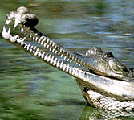|
Bhutan's
Nature - Animals
|
 |
Bhutan Nature Animals |
|
 |
Bhutan Information |
|
|
 |
| Male
Gharials for Norgay crocodile breeding centre |
 |
 |
| Phuentsholing
welcomed a rather unusual visitor - a 12-foot male gharial (gavialis gangeticus)
crocodile.
The
reptile travelled several hundred kilometres by road from Chitwan National
Park in Nepal to its new home at the Norgay crocodile breeding centre in
Phuentsholing. |
|
 Gharials
are highly endangered Gharials
are highly endangered |
It
was the second male gharial to be transported to Bhutan, the first one
came by air on April 26, 2004 and will help to breed the endangered
reptile at the Norgay breeding centre which has four gharials of which
three are females. The forest department's wildlife incharge in Phuentsholing,
Kinley Tshering, said that the two males from Nepal were in good health
and of the right age for breeding. "We are looking forward to a successful
breeding programme," he said.
Last
year, three female gharials at the Norgay centre reached the mating age.
The forest authorities tried to "translocate" a male from Chennai, India
but it was not feasible. Early this year, a visiting delegation from the
Nepalese department of forests to Bhutan agreed to provide two male gharials.
"If the breeding programme is successful, we want to reintroduce the reptiles
in all the large river systems in Bhutan," said Kinley Tshering. "There
are indications that gharials were found in Manas in the past but due to
loss of habitat and poaching, their existence have been completely wiped
out," he said. Gharials today are highly endangered and are found in the
wild only in India and Pakistan. According to forestry officials, the reptile
has a vital ecological role as a master predator in the aquatic habitat.
It eats up the weak and deceased fishes and dead animals thus keeping the
river systems clean.
The
Norgay crocodile breeding centre was established sometime in the 1970s
with 12 crocodiles (crocodylus palustris) and seven gharials. Today the
centre has 16 crocodiles led by a nasty looking 10-feet long alpha-male
crocodile and four gharials. Only recently one among the four gharials
was identified as a male. The centre has had little success in breeding.
Of the many eggs laid by the crocodiles only 11 eggs could be successfully
incubated and hatched. There have been no hatchlings from the gharials
till date.
The
Norgay breeding centre is faced with an even greater and more immediate
problem - an acute lack of space for the reptiles. With barely 0.6-acre
area the centre was becoming small and crowded for the reptiles according
to Ram Bahadur Chhetri who has been working as a caretaker for the last
20 years. Rapid commercial constructions around the centre was also making
the centre dirty and suffocating for the animals. "Looking at its surroundings
and the small area of the centre, a much bigger place needs to be identified
very soon for the reptiles to survive," said Ram Bahadur Chhetri who added
that the reptiles lacked the space to move around and get enough exercise.
Recently,
one of the younger crocodiles died and according to the caretaker's observations
it died of obesity. "In its natural habitat it would have so much space
to move," he said.
The
head of the nature conservation division, Dr Sangay Wangchuk, agreed the
centre needs to shift out to a bigger space at the earliest but there was
no space available in Phuentsholing. The success of the gharial breeding
programme could hinge on the crammed situation of the breeding centre.
| Contributed
by WWF, Bhutan office |
 |
top
| Wildlife and People in Bhutan |
 |
| Information on Bhutan |
 |
| Links |
 |
 |
 |
External
links |
 |
Bhutan
Ministry of Agriculture
Renewable
Natural Resources
MOA |
 |
|
 |
|



